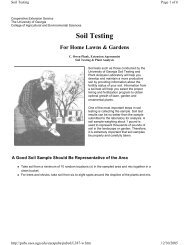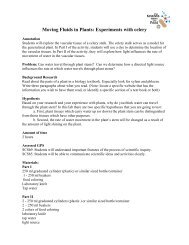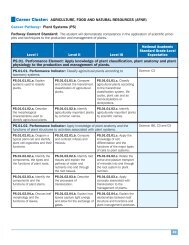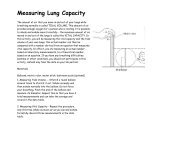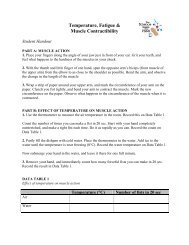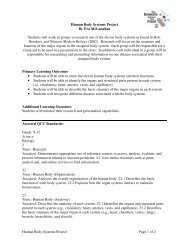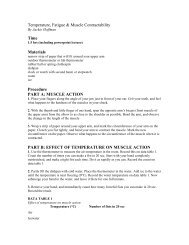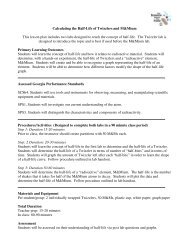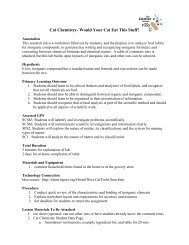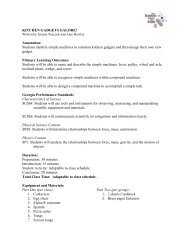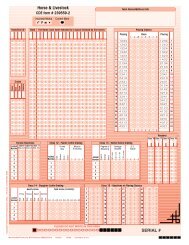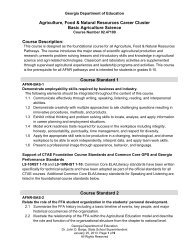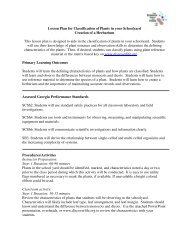Lesson Plan for Chemical Reactions of Antacid Relief ... - Haspi.org
Lesson Plan for Chemical Reactions of Antacid Relief ... - Haspi.org
Lesson Plan for Chemical Reactions of Antacid Relief ... - Haspi.org
You also want an ePaper? Increase the reach of your titles
YUMPU automatically turns print PDFs into web optimized ePapers that Google loves.
<strong>Lesson</strong> <strong>Plan</strong> <strong>for</strong> <strong>Chemical</strong> <strong>Reactions</strong> <strong>of</strong> <strong>Antacid</strong> <strong>Relief</strong> ProductsMagnesium Hydroxide and Aluminum HydroxideThis lesson plan is a tool to use when teaching chemical reactions. Students will synthesizemagnesium hydroxide and aluminum hydroxide using common household products. Teacherconclusions and review <strong>of</strong> lab will demonstrate the use <strong>of</strong> chemistry in society and how theproducts synthesized in this lab are used in everyday life.Primary Learning OutcomesStudents will learn the difference between the four main types <strong>of</strong> chemical reactions: Synthesis,decomposition, single replacement, and double replacement. Students will observe chemicalreactions taking place and determine the types <strong>of</strong> reactions that take place. Students will be ableto define precipitate and observe the <strong>for</strong>mation <strong>of</strong> precipitates. Students will determine abalanced chemical equation <strong>for</strong> each <strong>of</strong> the reactions.Assessed Ge<strong>org</strong>ia Per<strong>for</strong>mance StandardsSCSh2. Students will use standard safety practices <strong>for</strong> all classroom laboratory and fieldinvestigations.SCSh4. Students use tools and instruments <strong>for</strong> observing, measuring, and manipulating scientificequipment and materials.SCSh6. Students will communicate scientific investigations and in<strong>for</strong>mation clearly.SPS2. Students will explore the nature <strong>of</strong> matter, its classifications, and its system <strong>for</strong> namingtypes <strong>of</strong> matter.SPS6. Students will investigate the properties <strong>of</strong> solutions.SC2 Students will relate how the Law <strong>of</strong> Conservation <strong>of</strong> Matter is used to determine chemicalcomposition in compounds and chemical reactions.BackgroundIn Part I <strong>of</strong> this lab, you will react alum with ammonia. These are both compounds that dissolvein water. Household ammonia contains ammonium hydroxide. The hydroxide part <strong>of</strong> thechemical reacts with the aluminum in the alum. In Part II <strong>of</strong> this lab, you will react magnesiumsulfate (Epsom salt) with ammonia. These are both compounds that dissolve in water. Householdammonia contains ammonium hydroxide. The hydroxide part <strong>of</strong> the chemical reacts with themagnesium in magnesium sulfate.Page 1 <strong>of</strong> 8
Procedures/ActivitiesStep: 1 Duration: 10-15 minutesIntroduce or review the types <strong>of</strong> chemical reactions with students. Overheads may be usefulalong with images or analogies. See included overheads <strong>for</strong> examples.Step: 2 Duration: 5 minutesIntroduce lab and review directions as desired. Caution students about the use <strong>of</strong> householdammonia.Step: 3 Duration: 20-30 minutesStudents conduct the two part lab as shown in student handouts at the end <strong>of</strong> this document.Materials and EquipmentPer group: ½ teaspoon alum, 1 teaspoon magnesium sulfate (Epsom salt), 4 teaspoonshousehold ammonia, tap water, plastic spoons, 100 or 250mL beaker(Note: Alum can be found in most grocery stores on the spice isle. Epsom salt can be found atgrocery and drug stores on the first aid isle.)Total Duration35-50 minutes in classAssessmentLab report and/or discussion questions. Discuss questions as a class to assess the studentsunderstanding and ability to communicate scientific concepts. Discuss the reactions and whatcommon antacid relief products utilize the products synthesized in today’s reactions. Discusspossible methods to purify the products (filtration, evaporation, etc.). Assess studentunderstanding <strong>of</strong> concepts during the discussion and in post-lab report if desired.Page 2 <strong>of</strong> 8
Name __________________________Date __________<strong>Chemical</strong> <strong>Reactions</strong>: Part IBackground:Some chemical compounds will dissolve in water, and some will not. Sometimes, twocompounds that dissolve in water will react to <strong>for</strong>m a new compound that is insoluble (doesnot dissolve). This new compound comes out <strong>of</strong> solution and is referred to as a precipitate.In this lab, you will react alum with ammonia. These are both compounds that dissolve inwater. Household ammonia contains ammonium hydroxide. The hydroxide part <strong>of</strong> thechemical reacts with the aluminum in the alum.Materials:½ teaspoon alum2 teaspoons household ammoniaWaterPlastic spoonsBeakerProcedure:1. Fill the beaker ½ full with water.2. Add ½ teaspoon alum to the water and stir to dissolve the alum. Record observations.3. Stir in 2 teaspoons <strong>of</strong> ammonia. Record observations.CAUTION: ammonia has strong fumes, be careful not to breathe the fumes.4. Allow the solution to stand <strong>for</strong> 5 minutes. Record observations.5. Dispose <strong>of</strong> solution down the sink. Rinse the beaker well.Results/Observations:Step 2:Step 3:Step 4:Conclusions:1. Was there a new compound <strong>for</strong>med? (YES/NO) Explain how you know.2. What do you call this type <strong>of</strong> chemical reaction?3. How would you propose to purify the precipitate?4. Write the balanced chemical equation <strong>for</strong> this reaction.Page 3 <strong>of</strong> 8
Name __________________________Date __________<strong>Chemical</strong> <strong>Reactions</strong>: Part 2Background:Some chemical compounds will dissolve in water, and some will not. Sometimes, twocompounds that dissolve in water will react to <strong>for</strong>m a new compound that is insoluble (doesnot dissolve). This new compound comes out <strong>of</strong> solution and is referred to as a precipitate.In this lab, you will react magnesium sulfate (Epsom salt) with ammonia. These are bothcompounds that dissolve in water. Household ammonia contains ammonium hydroxide. Thehydroxide part <strong>of</strong> the chemical reacts with the magnesium in magnesium sulfate.Materials:1 teaspoon magnesium sulfate (Epsom salt)2 teaspoons household ammoniaWaterPlastic spoonsBeakerProcedure:1. Fill the beaker ½ full with water.2. Add 1 teaspoon <strong>of</strong> magnesium sulfate to the water. Stir to dissolve. Record observations.3. Add 2 teaspoons <strong>of</strong> ammonia to the beaker. DO NOT STIR! Record observations.CAUTION: ammonia has strong fumes, be careful not to breathe the fumes.4. Allow the solution to stand <strong>for</strong> 5 minutes. Record observations.5. Dispose <strong>of</strong> solution down the sink. Rinse the beaker and spoon well.Results/Observations:Step 2:Step 3:Step 4:Conclusions:1. Was there a new compound <strong>for</strong>med? (YES/NO) Explain how you know.2. What do you call this type <strong>of</strong> chemical reaction?3. How would you propose to purify the precipitate?4. Write the balanced chemical equation <strong>for</strong> this reaction.Page 4 <strong>of</strong> 8
THE NEXT SECTION INCLUDES OVERHEADSI. Maalox and Mylanta product in<strong>for</strong>mation (page 6)II. Synthesis and Decomposition Reaction Definitions/Examples (page 7)III. Single and Double Replacement Reaction Definitions/Examples (page 8)Page 5 <strong>of</strong> 8
MaaloxIndications: For the relief <strong>of</strong> acidindigestion, heartburn, sour stomach,upset stomach associated with thesesymptoms, pressure and bloatingcommonly referred to as gasMylantaIndications: For the relief <strong>of</strong> heartburn,acid indigestion, sour stomach,associated symptoms <strong>of</strong> gas and upsetstomach, overindulgence in food anddrinkActive Ingredients: Aluminumhydroxide (antacid), magnesiumhydroxide (antacid), Simethicone(antigas)Active Ingredients: Aluminumhydroxide (antacid), magnesiumhydroxide (antacid), Simethicone(antigas)How they contributeAluminum Hydroxide: Used in treatment <strong>of</strong> heartburn, gastritis, and peptic ulcerand sometimes to reduce absorption <strong>of</strong> phosphorus <strong>for</strong> people with kidney failure.Magnesium Hydroxide: Used <strong>for</strong> short-term relief <strong>of</strong> stomach upset and as alaxative <strong>for</strong> short-term treatment <strong>of</strong> constipation.Page 6 <strong>of</strong> 8
SYNTHESIS REACTION• Two or more substances combine to <strong>for</strong>m a more complexsubstance.• Two or more reactants yielding one product is another way toidentify a synthesis reaction.• Formation <strong>of</strong> a precipitate is a likely sign that a synthesis reactiontook place.DECOMPOSITION REACTION• A complex substance breaks down into its simple parts.• One reactant yields 2 or more products.• Synthesis and decomposition reactions are opposites.Page 7 <strong>of</strong> 8
SINGLE REPLACEMENT REACTION• A single uncombined element replaces another in a compound.• Two reactants yield two products.DOUBLE REPLACEMENT REACTION• Parts <strong>of</strong> two compounds switch places to <strong>for</strong>m two newcompounds.• Two reactants yield two products.Page 8 <strong>of</strong> 8



